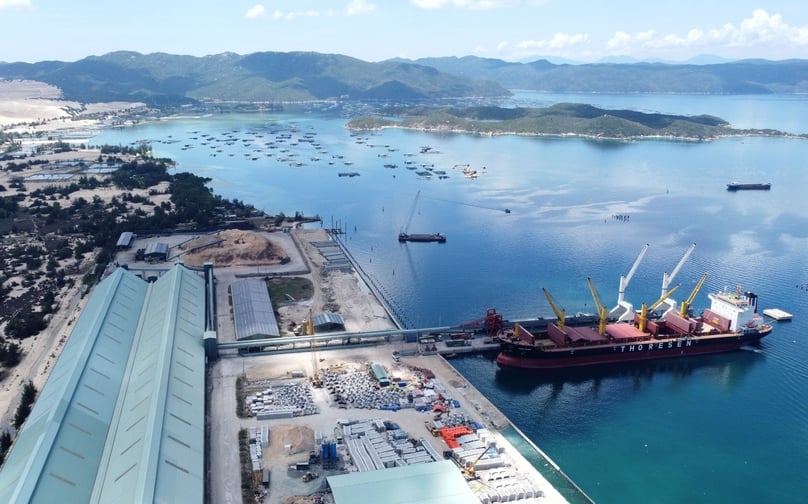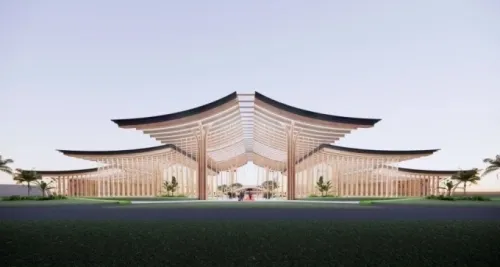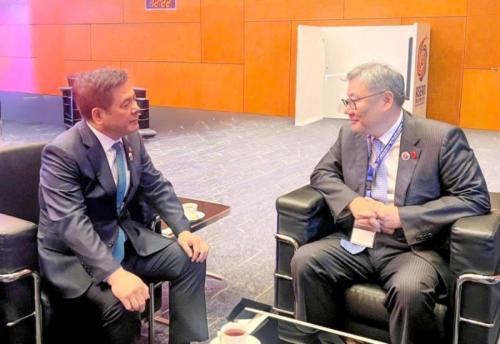Movement of mega projects creates momentum for central Vietnam's Van Phong Economic Zone
A series of large-scale projects in Van Phong Economic Zone are being accelerated, opening new prospects for breakthroughs in this key growth hub of Khanh Hoa province.
Removing bottlenecks in Van Phong-based projects
Located in northern Khanh Hoa, Van Phong Economic Zone (EZ) is set to become a multi-sector, integrated economic zone, with the marine economy as its foundation, linked to an international container transshipment port, logistics, industrial production, urban development, and tourism.
Covering 150,000 hectares, including 70,000 ha of land and 80,000 ha of water, the zone has completed 11 out of 19 functional subdivision plans.
In parallel, Khanh Hoa has planned 18 industrial parks (IPs) by 2030 with a total area of over 6,122 ha. Seven IPs have already been established, many of which have achieved high occupancy rates, such as Suoi Dau, Thanh Hai, and Ninh Thuy.
Currently, major projects in Van Phong EZ, including Dam Mon New Urban Area (nearly VND26,000 billion or $986.85 million in investment capital), Tu Bong New Urban Area (over VND43,000 billion), and Co Ma Premium New Urban Area (over VND5,970 billion) are facing delays in land verification and compensation due to staff shortages in local commune authorities. In addition, resettlement land for the Co Ma project has not yet been identified.
The Doc Da Trang Industrial Park project (groundbreaking in August 2025) is clearing 50 ha of land. Site clearance for phase 1 (116.25 ha) has been completed, and compensation plans have been publicly posted for phase 2 (170.76 ha).
At the Doc Let-Phuong Mai Tourism Area (over VND4,000 billion), the investor is finalizing land-use conversion and lease procedures for phase 1 (68.5 ha cleared) and selecting a consultant for environmental impact assessment and feasibility study preparation.
Meanwhile, the Hon Ngang-Bai Cat Tham Ecotourism Project has completed land leveling, mountain foot embankments in Zone C, and three model villas in Zone A. Construction of the main access road, coastal embankments, and infrastructure systems (stormwater drainage, wastewater, lighting, substations, etc.) is underway. Part of the project is expected to open by 2028.
Five additional projects are currently in the stage of seeking in-principle approval and investor selection, including the Ho Na Tourism and Residential Area (Dai Lanh commune), Hyundai Plant Expansion Phase 2, Ninh Diem 1 IP; Ninh Diem 3 IP; and Ninh Xuan IP (1,000 ha in Tan Dinh and Tay Ninh Hoa communes).
However, the Management Board of Khanh Hoa EZs and IPs reports delays in several projects due to various challenges, including the Ninh Long Residential Area, Ninh Thuy Residential Area, WhiteSand Resort, and Van Phong Premium Resort.
Strong impact from large-scale FDI projects
According to the management board, in the first nine months of 2025, Van Phong EZ attracted five new projects and three capital adjustments, totaling more than VND68,000 billion ($2.58 billion) in investment capital.
Additionally, 12 new projects and one capital increase were approved in industrial parks, with total capital exceeding VND11,300 billion.
Notably, the province has recently attracted the Ca Na Industrial Park project, with investment exceeding VND3,870 billion ($146.89 million), now undergoing phase 1 land clearance over 378 ha.
As of September, Van Phong EZ had drawn 128 investment projects with total registered capital of $7.85 billion, including 19 FDI projects worth $2.95 billion. Ninety projects are operational, employing 7,774 workers.
The province’s industrial parks have attracted 138 projects (107 domestic and 31 FDI) with total registered capital of $2.5 billion, of which 95 projects are already operational.
Prominent and efficient FDI projects include Hyundai Vietnam Shipbuilding (South Korea); Van Phong 1 BOT thermal power plant (Sumitomo Group, Japan, $2.58 billion); and four high-tech aquaculture and seafood processing projects by Australis Vietnam Ltd. (U.S., $68.19 million).
Others include projects from investors in South Korea, Japan, and Singapore in mechanics, building materials, and shipbuilding support industries.
A representative from HD Hyundai Vietnam Shipbuilding praised the increasingly favorable investment environment in Khanh Hoa, highlighting the local government’s open, fast, and effective support, particularly in land, production expansion, trade, labor, and environmental procedures.
“With this strong support, HD Hyundai Vietnam can maintain stable operations, expand long-term investments, and help make Khanh Hoa a regional hub for modern shipbuilding and maritime services,” the representative said.
“One-Stop” mechanism boosts investor confidence
According to Tran Minh Chien, head of the Management Board of Khanh Hoa EZs and IPs, the board has established a special task force to support investors under a “one-stop, one time commitment” mechanism, ensuring faster decision-making, quicker project implementation, and more job creation.
The board has also issued criteria allowing projects to have a maximum operational term of 70 years and proposed the provincial People's Committee release a set of standards for evaluating and prioritizing investors in industrial park development projects to enhance transparency and attract high-quality investments.
Ninh Thuan and Khanh Hoa were recwill form Khanh Hoa province, which borders Dak Lak, Lam Dong, and the East Sea.
Source: Nguyen Tri, Thai Ha
Photo: Photo courtesy of Khanh Hoa administration





